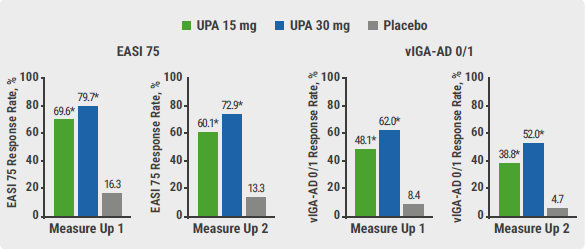Vitiligo patients have increased numbers of autoreactive, melanocyte-specific CD8+ T cells in their skin and blood, which are directly responsible for melanocyte destruction. In addition, gene expression in lesional skin from vitiligo patients revealed an IFNγ-specific signature, including the chemokine CXCL10. Experimental data in a mouse model identified a critical role for CXCL10 in both the progression and maintenance of vitiligo, thereby supporting inhibition of CXCL10 as a targeted treatment strategy for vitiligo patients [3]. Since IFNγ signal transduction occurs through JAK1 and 2, JAK inhibitors could lead to blockade of IFNγ signalling and downstream CXCL10 expression. Indeed, a case report published in 2015 showed a treatment success with tofacitinib in a patient with vitiligo [4]. Another case report showed rapid skin repigmentation on oral ruxolitinib in a patient with coexistent vitiligo and alopecia areata [5]. “In this case report, skin repigmentation went hand in hand with a significant reduction of CXCL10,” explained Dr Mehdi Rashighi (Massachusetts Medical School, USA) during his presentation [1].
The latest proof-of-concept study for JAK inhibition in vitiligo was published recently [2]. In this randomised, double-blind, phase 2 study, adult patients with vitiligo were treated with ruxolitinib cream in different doses (0.15% up to 1.5% twice daily). The primary endpoint was the proportion of patients achieving a 50% or higher improvement from baseline in the facial Vitiligo Area Severity Index (F-VASI) at week 24. In the highest dose group, 30.3% of patients achieved this endpoint, a percentage that increased to 51.5% after 52 weeks. At this time, a third of the patients even gained an F-VASI-90 response. “Clearly, the best response was seen with the 1.5% ruxolitinib cream applied twice daily,” Dr Rashighi stated. The tolerability of the cream was good; only acne was seen more frequently than in the vehicle group. Enrolment for a phase 3 trial with this cream is already completed.
“Hopefully, within the next 5-8 years, we will have more therapeutic options in vitiligo,” concluded Dr Rashighi.
- Rashighi M. JAK family inhibitors – In vitiligo. D1T06.3A, EADV 2020 Virtual Congress, 29-31 Oct.
- Rosmarin D, et al. Lancet 2020;396:110-20.
- Rashighi M, et al. Sci Transl Med 2014;6:223ra23.
- Craiglow BG, King BA. JAMA Dermatol 2015;151:1110-2.
- Harris JE, et al. J Am Acad Dermatol 2016;74:370-1.
Posted on
Previous Article
« JAK1 inhibition successful in hidradenitis suppurativa Next Article
Ligelizumab for chronic spontaneous urticaria: a new star on the horizon »
« JAK1 inhibition successful in hidradenitis suppurativa Next Article
Ligelizumab for chronic spontaneous urticaria: a new star on the horizon »
Table of Contents: EADV 2020
Featured articles
Late-Breaking News
Selective IL-23 blocker shows potential in psoriasis treatment
Promising results with nanobody treatment in psoriasis
Light at the end of the tunnel for chronic hand eczema
Epidermolysis bullosa: Novel wound treatment on the horizon
Efficacious non-steroidal topical for psoriasis
Oral JAK 1 inhibitor leads to fast itch relieve and remarkable skin clearance in AD
COVID-19: What Dermatologists Need to Know
Biologic psoriasis treatment and COVID-19 risk: Contradictory results
Much to be learned about COVID-19 and the skin
JAK Inhibitors – A Fascinating Novel Drug Class
JAK inhibitors in AA: re-establishing the immune privilege of hair follicles
JAK1 inhibition successful in hidradenitis suppurativa
Topical JAK inhibition: a novel treatment option for patients with mild-to-moderate AD
Urticaria – What’s new
Chronic inducible urticaria can require some detective work
Chronic spontaneous urticaria: hives, wheals & biomarkers
Ligelizumab for chronic spontaneous urticaria: a new star on the horizon
Infectious Diseases: Novel Developments
Bacterial resistance in skin infections – a challenging threat
Borreliosis: A multifaceted disease
Scabies – A global health challenge
Upcoming Treatments
Meaningful sleep improvement with IL-13 inhibition
Preventing foot odour with zinc oxide coated socks
Baricitinib in AD: Efficacy paired with consistent long-term results
Best of the Posters
Real-world data on brodalumab affirms efficacy and fast onset of action
Heightened risk for psychiatric comorbidities in hidradenitis suppurativa patients
Effects IL-13 blocker improves with longer treatment duration
Related Articles


December 18, 2020
Letter from the Editor
© 2024 Medicom Medical Publishers. All rights reserved. Terms and Conditions | Privacy Policy
HEAD OFFICE
Laarderhoogtweg 25
1101 EB Amsterdam
The Netherlands
T: +31 85 4012 560
E: publishers@medicom-publishers.com

